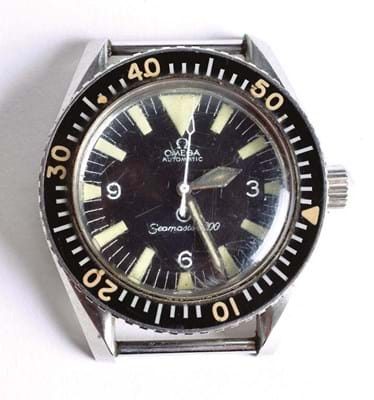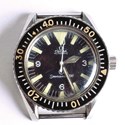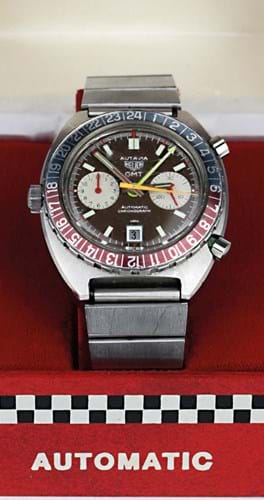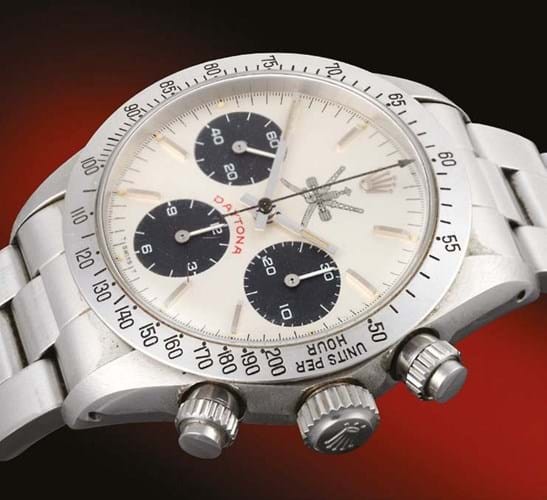It was the publication of The Silent World by Jacques Cousteau in 1953, and success of a Palme d’Or-winning film of the same name in 1957, that forged a generation of recreational divers – and a spike in demand for the bespoke diving watch.
This was the era of the Blancpain Fifty Fathoms (as worn by Cousteau in Le Monde du Silence), the first Rolex Submariner (1953) and the Omega Seamaster (1957).
All are characterised by dial sizes and designs that maximised legibility and an external rotating bezel to indicate just how many minutes had elapsed when under water. All are today among the most desirable of all vintage ‘tool’ watches.
Demand for market-fresh pieces typically far exceeds supply. The auction at Hannam’s (23% buyer’s premium) of Selborne on June 26 included a group of three late 1960s-80s watches offered for sale by the family of the original owner, a keen recreational and professional diver from the 1960s. They proved, said Hannam’s, the most popular lots the firm had ever sold.
The trio included a version of the uber-collectable Rolex military issue Submariner or Milisub. Rolex supplied reference 5513 watches for British special forces throughout the 1970s, although over the course of the decade this numbered as few as 1200 units. Of these only a third are thought to have survived in original condition retaining ‘sword’ hands’ and a new style bezel calibrated to 0-60. A letter T within a circle to the dial denotes the presence of titanium.
The example here, made c.1972 with the MOD number and a 1974 issue date to the case back, had been serviced in the 1990s when the hands and bezel had been replaced (it now had orange ‘mercedes’ hands). It nonetheless attracted more than 140 ‘watchers’ on thesaleroom.com and the firm was forced to decline phone bids after requests became unmanageable. Estimated at £5000-8000, the hammer price tendered by a UK bidder was £44,000.
Dials, bezels, hands and crowns were often replaced during Rolex servicing. Today there is a premium to be paid for watches that – like the ‘oily rag’ classic car – escaped regular episodes of restoration and replacement. The watch in battle-worn but original condition is the rarity.
Some of the Rolex Oman watches have acquired near-mythical status in the collecting community
An Omega Seamaster 300 military issue dive watch c.1968 with a 1970 issue date was in rough but untouched condition. The MOD purchased the Seamaster 300 for its divers between 1967-71. This version had the ‘big triangle’ dial – so-called as a large arrow takes the place of the number 12. It sold at £32,000 (estimate £2000-3000) to a different UK bidder.
Although not in the same financial league, the Royal Navy Precista diving watch is arguably the rarest of all British military dive watches, as it was issued from 1981-82 in a run of 2000 units. The distinctive features (the watch has recently been reissued) include an asymmetrical case and ‘snake head’ hands. Reissues are plentiful but vintage examples uncommon. One sold for £3800 at Watches of Knightsbridge in 2016. This Hannam’s example took £2000.
Rolex Submariners
Two other vintage Rolex Submariners appeared for sale in recent auctions.
A reference 5512 sold by Chiswick Auctions (25/12% buyer’s premium) for £21,400 on June 13 dated from c.1963. Two features are of note: pointed crown guards or ‘cornino’ that followed criticism that the watch was too bulky and the small radium dot at the six o’clock position that resembles an exclamation mark. These dials were produced for only a short period of time, between 1961-62.
Dreweatts’ (25/20/12% buyer’s premium) sale on July 10 included a reference 5513, c. 1971 of the ‘Comex’ type. It features a helium escape valve at nine o’clock, a new development for divers working from a diving bell in a helium-rich environment.
This watch came from the family of Johny Henry Simpson, a diver in the Royal Navy who later worked on the Manchester Ship Canal and on North Sea oil rigs with Comex. On his retirement from diving John was presented with this Submariner by a former pupil. In commercial terms its prospects were curtailed by a replacement service dial but it sold just below hopes at £14,250.
Taking its name from a combination of its target markets (automotive and aviation), the Heuer Autavia wristwatch was unveiled in 1962. It was the watch that established the brand’s racing credentials. There are many variants.
Purchased in 1971 and in its original box with some paperwork, a Heuer Autavia Ref 1163 chronograph sold for £10,500 (estimate £3000-4000) at Lockdales of Ipswich on June 12. This version has a ‘Pepsi’ coloured GMT bezel – a scarce type that includes all 24 hours.
The most valuable watch sold in the UK regions in recent weeks appeared at Tennants (20% buyer’s premium) of Leyburn on July 13. This reference 6263 Rolex Daytona is better known as the ‘Big Red’ on account of the lettering to the dial but this example c.1979 was also printed with the white ‘khanjar’ motif, the national symbol of Oman.
Sultan Qaboos Bin Said al Said began a collaboration with Rolex in the early 1970s, typically ordering bespoke watches in small batches that were given as tokens of appreciation. This watch was first owned by a pilot that served in the region and had last changed hands in the 1990s.
Some of these Rolex Oman watches have acquired near-mythical status in the collecting community and have achieved huge prices. This Big Red joined them when it took £125,000 (estimate £25,000-35,000).




















